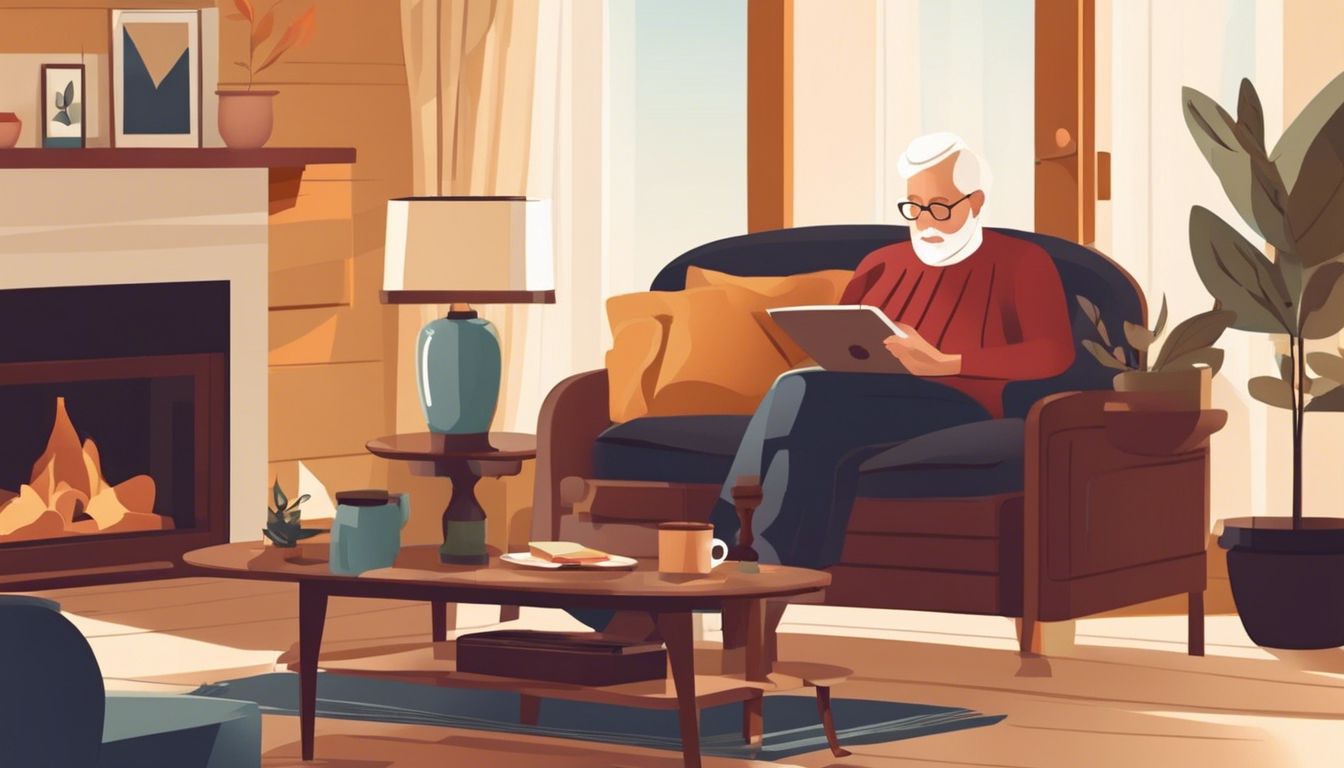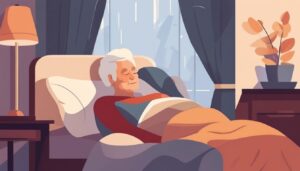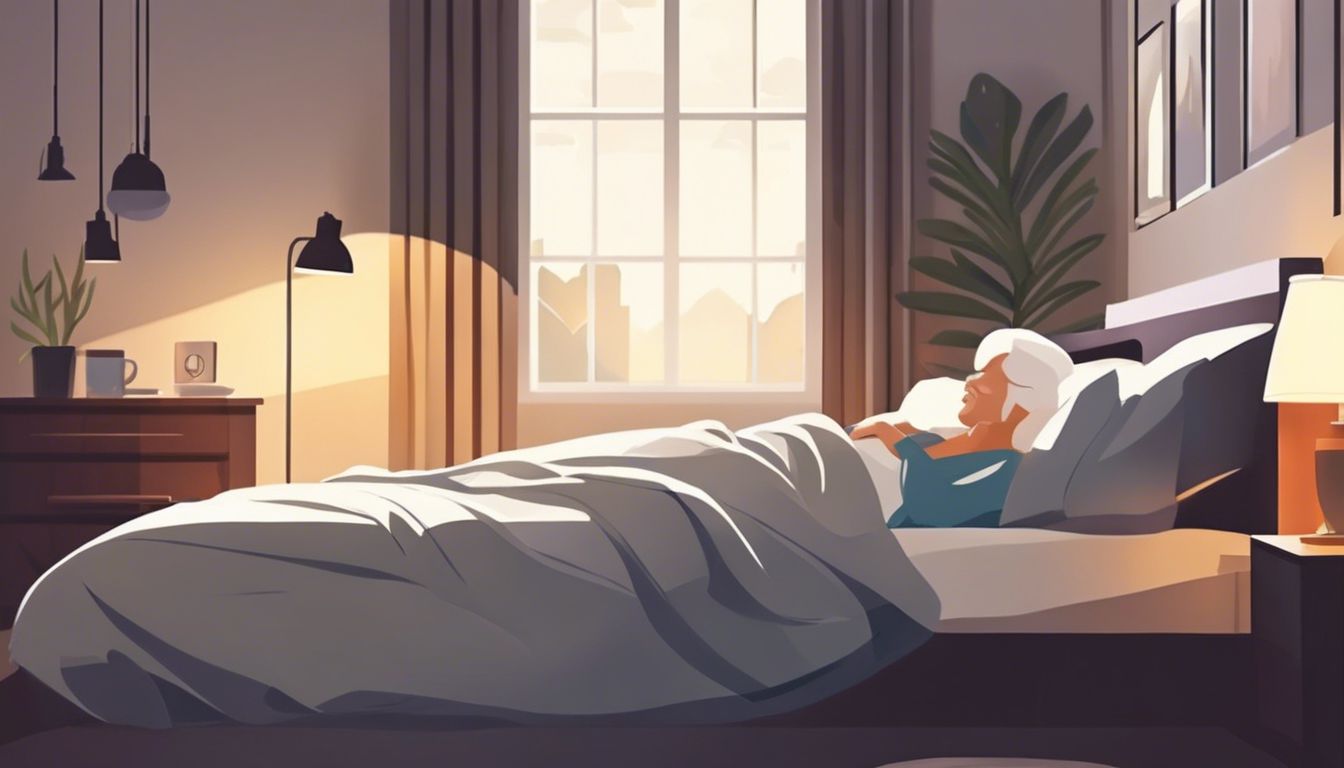Creating a senior-friendly living room poses challenges for many caregivers. Over 90% of seniors prefer to age in place at home. This guide offers practical tips to enhance comfort and safety in living spaces.
Learn how to transform your loved one’s living room today.
📋✅
- Over 90% of seniors want to age in place at home, so creating a safe and comfortable living room is important.
- Choose sturdy furniture with firm cushions, high backs, and armrests to help seniors sit and stand easily.
- Create clear 32-inch wide pathways for mobility aids by removing clutter and arranging furniture strategically.
- Install bright, non-glare LED lighting with easy-to-reach switches to reduce fall risks and improve visibility.
- Use non-slip flooring options like textured tiles, low-pile carpets, or cork to prevent accidents and provide stability.
Essential Furniture Arrangement Tips

Proper furniture arrangement enhances safety and comfort for seniors. Strategic placement of chairs, tables, and assistive devices creates a functional living space.
Selecting safe and accessible furniture
Safe, accessible furniture is crucial for senior-friendly living rooms. Choose sturdy chairs and sofas with firm cushions and high, straight backs for easy sitting and standing. Opt for armrests that extend slightly beyond the seat edge to provide support.
Select tables with rounded corners to prevent injuries from accidental bumps. Prioritize adjustable-height furniture, like recliners or beds, to accommodate changing mobility needs.
Ensure all furniture pieces are stable and won’t tip over if leaned on for support.
Upholstery materials matter for senior comfort and safety. Leather or microfiber fabrics are easy to clean and maintain. Avoid slippery materials that can cause falls. Pick furniture frames made of solid wood or metal for durability.
Install grab bars near seating areas for extra stability. Place essential items within easy reach to minimize stretching or bending. These choices enhance comfort and reduce fall risks for seniors aging in place.
Creating clear pathways for mobility aids
Creating clear pathways for mobility aids is crucial for senior safety and independence. This process involves strategic planning and thoughtful layout adjustments.
- Remove obstacles: Clear all clutter, loose rugs, and unnecessary furniture from walkways.
- Widen doorways: Ensure doorways are at least 32 inches wide to accommodate wheelchairs and walkers.
- Install handrails: Place sturdy handrails along hallways and staircases for support.
- Use non-slip flooring: Apply non-slip mats or strips in high-traffic areas to prevent falls.
- Arrange furniture strategically: Position seating with ample space between pieces for easy navigation.
- Secure electrical cords: Tuck away or tape down all cords to prevent tripping hazards.
- Improve lighting: Install bright, glare-free lighting throughout the living space to enhance visibility.
- Create rest areas: Place chairs or benches at regular intervals for seniors to rest during long walks.
- Mark thresholds: Use contrasting colors to highlight changes in floor levels or materials.
- Maintain clear sightlines: Ensure important areas like the bathroom and kitchen are easily visible from main living areas.
Enhancing Safety with Appropriate Lighting and Flooring
Proper lighting and flooring are crucial for senior safety. Bright, glare-free lights reduce fall risks, while non-slip floors provide secure footing.
Installing bright, non-glare lighting
Proper lighting is crucial for senior safety and comfort. Bright, non-glare lighting reduces fall risks and enhances visual perception.
- Install LED bulbs with high lumens for bright, energy-efficient illumination
- Use frosted or diffused light fixtures to minimize glare
- Place lamps strategically to eliminate shadows in walkways and corners
- Add dimmer switches for adjustable lighting levels throughout the day
- Incorporate task lighting in reading areas and near frequently used furniture
- Install motion-activated lights in hallways and bathrooms for nighttime safety
- Choose warm white (2700-3000K) bulbs for a cozy, comfortable atmosphere
- Use table and floor lamps with easy-to-reach switches for convenience
- Add under-cabinet lighting in the kitchen for improved visibility during meal prep
- Install nightlights in bedrooms and bathrooms to guide safe nighttime movement
Choosing non-slip flooring options
Non-slip flooring is crucial for senior safety in living rooms. Consider these options to reduce fall risks:
- Textured tiles: Ceramic or porcelain tiles with a rough surface provide excellent traction.
- Low-pile carpets: Short, dense fibers offer stability without impeding mobility aids.
- Cork flooring: Natural, eco-friendly material with cushioning and slip-resistant properties.
- Rubber flooring: Durable, shock-absorbing surface ideal for high-traffic areas.
- Vinyl with embedded grit: Affordable option with built-in slip resistance.
- Stone flooring: Natural stone like slate or granite offers texture and grip.
- Epoxy coatings: Applied over existing floors to increase traction.
- Engineered hardwood: Textured finish provides better grip than smooth surfaces.
Dietary Considerations for Comfortable Senior Living
Proper nutrition plays a crucial role in seniors’ quality of life. Caregivers should focus on easy-to-prepare, nutrient-dense meals that support health and independence. Stock the fridge and pantries with soft, easily chewable foods for those with dental issues.
Install pull-out shelves in cabinets to improve accessibility and reduce the risk of falls. Create a cozy seating area in the kitchen to encourage social interaction during meal times, which can boost emotional health.
Ensure adequate lighting in food preparation areas to accommodate vision impairments and promote safe cooking practices.
https://www.youtube.com/watch?v=kBsNqQqA5XU
Conclusion
Creating a senior-friendly living room boosts comfort and safety for older adults. Smart design choices make daily activities easier and reduce accident risks. Proper furniture arrangement, lighting, and flooring contribute to a more accessible space.
Consider adding assistive devices like grab bars or transfer benches for extra support. These thoughtful modifications help seniors maintain independence and enjoy their golden years at home.
For more information on nutritional adjustments to aid in creating a comfortable environment for seniors, visit dietary changes that enhance comfort for seniors with digestive issues.
FAQs
1. How can I improve natural lighting in a senior’s living room?
Install skylights or use window film to maximize natural light. Good lighting aids eyesight and boosts mental health during golden years.
2. What furniture designs are best for seniors?
Choose ergonomic designs with easy access. Transfer benches and slipcovers enhance comfort and ease of use for older adults.
3. How can I make the living room safer for seniors?
Install motion sensors, smoke detectors, and carbon monoxide detectors. These devices help prevent accidents and maintain body temperature.
4. What décor elements promote comfort for seniors?
Use warm colors and soft textures. Add personal items that evoke positive memories to combat depression and improve mental well-being.
5. How can I incorporate universal design in the living room?
Focus on accessibility. Wide doorways, non-slip flooring, and adjustable furniture accommodate various physical needs and promote independence.
6. What technology can benefit seniors in the living room?
Set up devices for online learning and entertainment. Smart home systems can control lighting, temperature, and security, enhancing comfort and safety.









